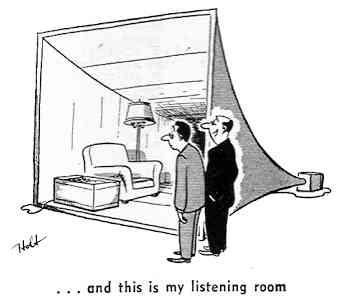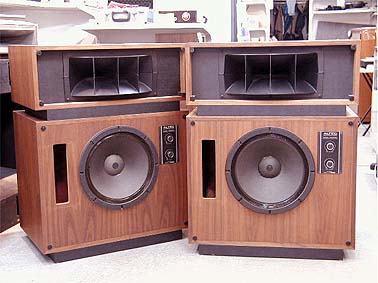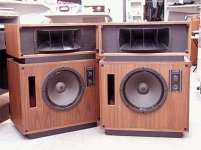Can you provide a link to the SEOS 24/MTML shown?Klipsch has measurements showing that the Jubilee corner bass horn(41.7" W x 39.75" H x 24.5 D) with two premium 12" woofers has smoother SPL, slightly higher average SPL, and a smaller physical size than the original Klipschorn.
Simulations of the Faital 15FH520 woofer in 6,8,10 cuft ported box volumes illustrate the potential of ~100db/watt SPL 35Hz bass with corner placement gain. A tall MLTL with acceptable 28"-30" width is worth study for 3-watt amplifiers. Other potentially superior MLTL 15" woofers probably exist.
It appears you've built at least one.
PS: A passive filter circuit integrated in tube amp would be very interesting, but I have never heard of that kind of thing, albeit it seems like it can be done rather easily.
with the right combination of horns/drivers/amps and setup this can be very satisfying. It can be passive line level if the input impedance is kept high enough and you use a low impedance source - again the amps need to be dead quiet
I also was wondering if listening distance (around 3m, 10') is not too short for a big 2-3 way horn speaker.
The other alternative would be a corner coaxial speaker (Altec 604 or Radian 5215) in BR (Altec 606 like or Billfort) or BHL (Brociner...).
What would you advice ? Do some of you ever compared 604 and 5215 ?
Radian can provide Neo and Berylium diaphragm, any experiences ?
Knowing than active DSP crossovers and EQ (room correction) with Rephase and Minisharc can be applied (2A3 DC for med-high, Hiraga class A 20W for bass under 1000Hz).
The other alternative would be a corner coaxial speaker (Altec 604 or Radian 5215) in BR (Altec 606 like or Billfort) or BHL (Brociner...).
What would you advice ? Do some of you ever compared 604 and 5215 ?
Radian can provide Neo and Berylium diaphragm, any experiences ?
Knowing than active DSP crossovers and EQ (room correction) with Rephase and Minisharc can be applied (2A3 DC for med-high, Hiraga class A 20W for bass under 1000Hz).
Jitter is a red herring in today's DACs. However, AM and FM distortion from your loudspeakers due to cone motion is an issue. Recommend horn-loaded bass (time aligned). See Red Shift: Doppler distortion in loudspeakers | Stereophile.com
Chris
NO NO NO NO NO NONONONONO!
(Doppler distortion, as commonly used in the audio word, it a trigger for me.)
YES! To the last part of your post that I deleted.
Stereophile wrote:
Something similar happens when a loudspeaker diaphragm reproduces a sound. While the diaphragm is moving toward the listener, the frequency of the radiated sound increases; as it moves away, the frequency decreases.
This is wrong wrong wrong wrong wrong. (I am barely resisting the urge to go all caps again. (And I am so moved to fix this, that I am not even reading the rest of the thread to see if it has been addressed yet.)
When two sine waves of differing frequencies are combined, basically, one "rides" on top of the other. They combine, mathematically. If one speaker is producing 100hz sine wave, and another speaker is producing 1000hz sine wive, there is no difference than if one speaker were producing a combined signal of the two. In the air, the two signals combine, the same as if one source were producing them.
(To be pedantic, the single source is better than two sources, as the two will combine to different effect if you move your position relative to the two sources.)
Our ear hears one signal. Not multiple. If there are multiple signals, they combine, as one. So to replicate them, it is the reverse.
The distance from the source does not change. (Unless you run towards your speakers, or they fall out of the window away from you, or someone runs away with them, stealing them, while you are still listening to them, or they lunge at you from across the room.) The distance to the magnet remains the same. Where the Voice Coil (VC) is at rest, and the "center" of your signal is constant.
So no matter how loud you play them, how much excursion you get, how much 20hz sine wave you play, the rest stays the same in relativity to it.
About 20 years ago Cerwin Vega wrote an article positing the same thing. I brought it up to Tom Danley about 15 years ago, and was soundly, politely, scientifically, and positively refuted.
Regards, Jack
PS, Tom did admit that if you got loud enough to distort the air, that something like that could happen. This is about 47dB past the threshold of pain, IIRC.
If doppler distortion were a thing, if a piccolo were playing, and the tympani started thumping, the piccolo would start wavering in pitch. It does not. The two signals simply combine.
Clearly you didn't read Keith Howard's excellent article.
[...Or any of PWK's articles on the subject. Or see the results of 100 dB@1 m SPL dual-tone testing on real loudspeakers on a signal analysis system...]
It's okay...you'll feel "right as rain" in the morning if you don't read it.
Chris
[...Or any of PWK's articles on the subject. Or see the results of 100 dB@1 m SPL dual-tone testing on real loudspeakers on a signal analysis system...]
It's okay...you'll feel "right as rain" in the morning if you don't read it.
Chris
does it mean that vented which give far less dopler distorsion than sealed designs are always the best ? (I haven't read the article yet!)
You might need to read a bit more. Doppler distortion is FM distortion. Howard is mostly talking about FM distortion, which is proportional to diaphragm motion and is usually controlled by limiting the pass bands and using more than one "way". Direct radiating drivers must move 5-7 times as far (p-p) to produce the same SPL on axis relative to using the same driver behind a well-designed horn. FM and AM distortion products are much lower (less than -20 to -25 dB on average) in horn-loaded loudspeakers as a result and sound much "cleaner". Nelson Pass also wrote a very good article on this subject, except it is concerning amplifiers. Refer to his "elephant on the dance floor" comments.
The dominant distortion out of a woofer (direct radiating) is AM distortion. Read the Klippel articles on the subject - especially the modulation distortion test procedures. They're really good.
Vented boxes produce gobs of audible group delay distortion near the port resonance frequency. That's why they don't sound very "tight" relative to sealed boxes.
The Howard article linked above makes the insightful connection of digital "jitter" to FM distortion products in loudspeakers-and the AM distortion products are at least an order of magnitude higher than typical electronic system jitter levels in direct radiating woofers. The two distortion types merge upon output from the loudspeaker.
No one is talking about DC offsets in modulated frequencies (i.e., "train whistles"). You might want to reconnect with a signal processing textbook.
The dominant distortion out of a woofer (direct radiating) is AM distortion. Read the Klippel articles on the subject - especially the modulation distortion test procedures. They're really good.
Vented boxes produce gobs of audible group delay distortion near the port resonance frequency. That's why they don't sound very "tight" relative to sealed boxes.
The Howard article linked above makes the insightful connection of digital "jitter" to FM distortion products in loudspeakers-and the AM distortion products are at least an order of magnitude higher than typical electronic system jitter levels in direct radiating woofers. The two distortion types merge upon output from the loudspeaker.
No one is talking about DC offsets in modulated frequencies (i.e., "train whistles"). You might want to reconnect with a signal processing textbook.
Last edited:
For classical beware of high efficiency barking dogs...😀
Sakuma's old 78rpm jazz collection is quite another stuff...😎
For classical, the more analytical, dry and neutral uncolored aseptical sounding, the very best. Low efficiency usually excel in these respects, while high eff, well, quite the other way...
Words of wisdom
I will add, get the best tweeter possible, minimum an excel millennium.
A couple of subs can also help getting the sound of those big drums right and tons of room treatment, carpets and the wall behind you completely covered with acoustical stuff or art deco which has sound damping properties.
I know a guy who uses a 300B SE monblock set with Altec 604's in onken style cases (custom build for the 604's) and he only listen classic music and jazz. To me it sounds very good (but i'm no expert in classic music) and surely loud enough for the 8x6x3 meter music room he uses. He also got B&W 800D's amped with passlabs amps, and i rather have the 300B/604 combo than those but that's maybe because he plays only (high quality) digital recordings...
Words of wisdom
I will add, get the best tweeter possible, minimum an excel millennium.
A couple of subs can also help getting the sound of those big drums right and tons of room treatment, carpets and the wall behind you completely covered with acoustical stuff or art deco which has sound damping properties.
I am not a big fan of room treatment, reflections being a no brainer against common wisdom. I believe drivers/speakers linear distortion what really matters and hi eff drivers made of light paper cones, no matter the pressed non pressed nuance, the way they are dried, the presence of cotton, wool, wood, carbon fiber or kevlar strctural aids or superficial snake oil dammar varnish or similar useless treatments, all suck to this respect. Exceptions welcome of course, but hi eff cones mean light paper cones, and this is a flawed stuff by nature. Lowther, Fostex or Altec cones are familiar hi eff as usual junk stuff, in spite of having their devoted followers...
Last edited:
[Listening test / DIY design] Altec A7 Clone : All BS ?
We can certainy also horn the classical low efficienty drivers for home needs !
Ah Does X, want to add at his foam horned SS 10F/84 an A5 foam cabinet with a scanspeak 10" for the low end < 700/500 Hz ?
We can certainy also horn the classical low efficienty drivers for home needs !
Ah Does X, want to add at his foam horned SS 10F/84 an A5 foam cabinet with a scanspeak 10" for the low end < 700/500 Hz ?
Last edited:

From the TNT paper part II:
Where they stand out in comparison to the normal type of speaker is that the whole range is tonally correct as far as I can hear. In part, this is due to some "blending" between the two different bass drivers and the way the multi cells have tamed the D252 HF driver. There is no real sweet spot, other than in the high treble in the main due to the multi cells almost spreading the sound around - in fact it is possible to hold an LP cover between either speaker and ones head without noticeably changing the sound. The usual caveats about recordings apply but with any reasonably good one the speakers disappear (it helps to close your eyes as ignoring the things visually is a bit difficult!) and all that's left is this wonderful sound field with instruments sounding in different places. As it should be.
Try aclimate and enjoy!

@Pooh
in re: to the "Beyond the Ariel": it IS a long and confusing thread; it took them forever but they DID complete a few versions of the speaker and the first one was made by Gary Dahl who is professionally into classical music. so i linked his comments.
That whole thread can be condensed into:
1) Get a good 1.4" and stick it on an Azura horn (or equivalent)
2) Add an efficient 15" in a ported box
Basically, its a more curvy Altec 19.
Attachments
Too-Small & Non-Cohearant
For your application use of either of these smaller cabinets is contraindicated if you want to reproduce the 'big-air' of a full concert orchestra.
If anything, I would be looking at an even bigger bass horn & drivers. With the K402 on top, the c/o between it and the bass unit could be set lower to accommodate such a configuration.
Regards,
WHG
Thanks for your advices !
K402 is interesting, but a bit too big for me.
Listening point will be at 10', maybe coaxial or full range shall be better. Listening room 12'*15'*10' height.
For GPA 604, a good choice I saw :
- Brociner Jensen corner Horn
- Altec 606
In a general way, how could the Altec sound be described compared to Tannoy or Klipsch ?
An externally hosted image should be here but it was not working when we last tested it.
An externally hosted image should be here but it was not working when we last tested it.
For your application use of either of these smaller cabinets is contraindicated if you want to reproduce the 'big-air' of a full concert orchestra.
If anything, I would be looking at an even bigger bass horn & drivers. With the K402 on top, the c/o between it and the bass unit could be set lower to accommodate such a configuration.
Regards,
WHG
NO NO NO NO NO NONONONONO!
(Doppler distortion, as commonly used in the audio word, it a trigger for me.)
...
Regards, Jack
Doppler Distortion denial is one of my triggers - you are working from the wrong model - and measurements verify the correct theory - from ESP to Klippel
yes independent sources add linearly in air - but different frequency sounds radiating from a single cone are not independent sources - the piccolo's notes are literally riding on the motion of a single driver cone if it is also being driven with the tympani thumps in a full range single driver speaker
ESP did go in a bit of circle "discovering" that the FM/Phase modulation IM distortion description is equivalent to the "Doppler" calculation
and he measured it too: Doppler Distortion in loudspeakers
and https://www.klippel.de/ search there for Doppler
... Bl(x) generates significant intermodulation throughout the audio band. The distortion generated by inductance nonlinearity L(x), L(i) and Doppler rise to higher frequencies. The figure above shows the results of three different distortion measurements. The blue curve shows high values of ...
Last edited:
what informs your opinion?
so basically he opposite conclusion to Dr Earl Geddes with his published AES speaker distortion audibility work, his work on the OS waveguides, his professional work on Acoustics, his Home Theater setup, book...
so basically he opposite conclusion to Dr Earl Geddes with his published AES speaker distortion audibility work, his work on the OS waveguides, his professional work on Acoustics, his Home Theater setup, book...
I am not a big fan of room treatment, reflections being a no brainer against common wisdom. I believe drivers/speakers linear distortion what really matters and hi eff drivers made of light paper cones, no matter the pressed non pressed nuance, the way they are dried, the presence of cotton, wool, wood, carbon fiber or kevlar strctural aids or superficial snake oil dammar varnish or similar useless treatments, all suck to this respect. Exceptions welcome of course, but hi eff cones mean light paper cones, and this is a flawed stuff by nature. Lowther, Fostex or Altec cones are familiar hi eff as usual junk stuff, in spite of having their devoted followers...
These things sound awfully "OLD" and should now live in museums. I dont think authorities, Toole, Geddes, etc.. would disagree on this...🙄


so basically he opposite conclusion to Dr Earl Geddes with his published AES speaker distortion audibility work, his work on the OS waveguides, his professional work on Acoustics, his Home Theater setup, book...
Don't misquote, Don Quixote of audio! These old altec pa trumpets are no OS waveguides, simply crap, just listren! Too much reading no good for the brain...😀
Last edited:
Now it all depends on what is understood as classical music...
This for instance is a piece of cake for any speaker and possibly will sound richer with vintage amps and speaker, ala Sakuma...
https://www.youtube.com/watch?v=l78VNe_dhAM
This is more difficult...
https://www.youtube.com/watch?v=R6IfpZUqERk
And this is one just too complex for any vintage speaker...
https://www.youtube.com/watch?v=Y9niwzsq9DI
Probably a bad modern digital recording of these only can sound half decent on a pair of Genelec low efficiency monitors...😀
This for instance is a piece of cake for any speaker and possibly will sound richer with vintage amps and speaker, ala Sakuma...
https://www.youtube.com/watch?v=l78VNe_dhAM
This is more difficult...
https://www.youtube.com/watch?v=R6IfpZUqERk
And this is one just too complex for any vintage speaker...
https://www.youtube.com/watch?v=Y9niwzsq9DI
Probably a bad modern digital recording of these only can sound half decent on a pair of Genelec low efficiency monitors...😀
Last edited:
- Home
- Loudspeakers
- Multi-Way
- What high efficiency speaker for Classical Music ?
